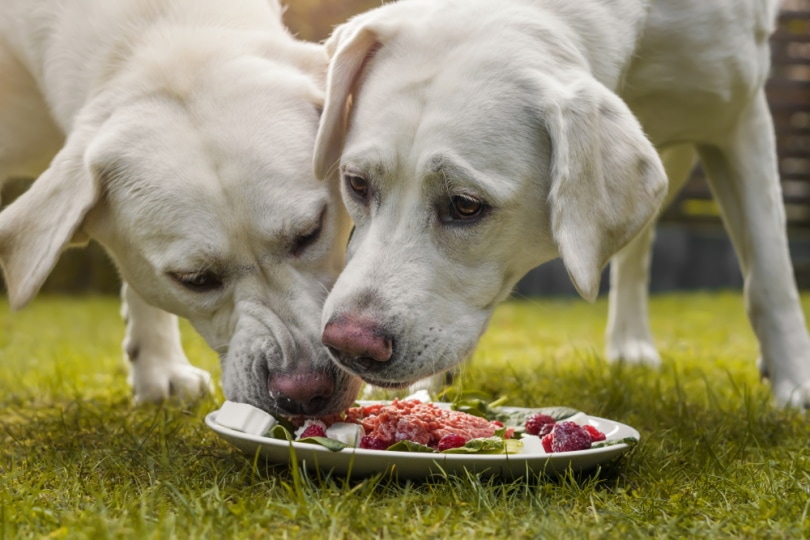In this article
View 2 More +A raw diet is a nutritional management plan that some owners seek for their pet dogs. The general acceptance of such a diet is on the rise, as many owners see it as the most biologically appropriate diet for their pets. There are also many anecdotal and scientifically explored benefits of such a diet.
Though the vast majority of perceived benefits of a raw diet do remain anecdotal at this point, it is also the most nutritionally appropriate option for owners who wish to prepare at-home, complete, and balanced meals for their pets. As such, knowing how much raw food to feed a dog is also important. This ensures that your pet is not being overfed or underfed. However, determining how much to feed your pet isn’t as straightforward as one might hope. Let’s explore why.

How Much Raw Food Should I Feed My Dog?
In order to know how much food your dog needs, you would have to know three crucial pieces of data.
- Your dog’s daily caloric requirements
- Your dog’s life stage and health status
- The food’s nutritional composition
Though this does seem conceptually simple, each of these three data points can be heavily modified by a myriad of factors. For example, your dog’s caloric requirements will vary depending on their sex, age, breed, neuter status, activity levels, and even the season! In turn, the amount you’d have to feed your dog would change as well.
In short, there’s no one-size-fits-all feeding chart possible for dogs when it comes to determining how much raw food you should feed your dog. However, hypothetical examples can give you a rough idea of what to expect, and keeping track of your dog’s health might shed further light on whether or not they’re being fed adequately.
Feeding Commercial Raw Diets
If your dog is on a commercial raw diet, they should be fed per the instructions on the label of the food itself. This is because the manufacturer has figured out how many calories are in their food and is, therefore, able to give you feeding recommendations on the label itself. These guidelines should be your primary point of reference.
However, keep in mind that commercial raw diets intended for adult dogs will not be nutritionally adequate for puppies. So, it’s important to ensure that you buy the food that is most appropriate for your pet for your dog’s age and life stage.
Feeding Homemade Raw Diets
The formulation of a homemade raw diet requires the input of both a veterinarian and an animal nutritionist. Veterinarians who are also certified as nutritionists can provide both of these services for your pet.
The input of professionals is key because not all pets are suitable candidates for a raw diet, and a clean bill of health alongside a “go ahead” from a veterinarian is considered an ethical necessity before pets can be transitioned to such a diet. In addition, a veterinarian will be able to assess your dog’s overall weight, muscle condition score, and body fat percentage and run other health screening assessments on your pet to determine their caloric requirements. This information is key for a nutritionist to inform on how much your dog needs to be fed on a daily basis.
Though animal nutritionists are able to formulate complete and balanced diets and know the diet’s nutritional composition, a veterinarian’s input is just as necessary to know how many calories your dog needs on a daily basis. As mentioned above, veterinarians who are also nutritionists may perform both these tasks for you. In many parts of the world, only veterinarians are allowed to become animal nutritionists (from a legal standpoint). However, laws vary by region, and this distinction is therefore necessary.
If you need to speak with a vet but can't get to one, head over to PangoVet. It's our online service where you can talk to a vet online and get the personalized advice you need for your pet — all at an affordable price!


Sample Raw Food Diet for Dogs Chart
Most homemade raw diets require anywhere between 5 to 10 ingredients to be nutritionally complete and balanced. Say a nutritionist manages to formulate a diet for your dog using the following ingredients:
- Chicken breast (with skin)
- Beef heart
- Whole eggs
- Beef liver
- Oysters
- Broccoli
- Carrots
- Bonemeal
For ease of calculation, let’s say your nutritionist balanced the weight of each ingredient so that the total yield of the diet is 1,000 kCal. Assume that the diet itself weighs 815 grams (around 29 ounces).
To determine how much of this diet a healthy, mixed-breed adult male being fed for maintenance would need (by their weight), the following approximations can be used with the sample diet from above.
| Dog’s Weight | Calorie Requirement (approximation) | Calories in Diet | Weight of Diet | Amount of Raw Food Required Per Day |
| 10 kg (22 lbs) | 452 kCal | 1,000 kCal | 815 g (29 oz) | 368 g (13 oz) |
| 25 kg (55 lbs) | 1130 kCal | 1,000 kCal | 815 g (29 oz) | 921 g (32.5 oz) |
| 35 kg (77 lbs) | 1583 kCal | 1,000 kCal | 815 g (29 oz) | 1,396 g (49 oz) |
Keep in mind that these are the approximations of the total requirements for these dogs on the assumptions of the diet’s nutritional yield. They aren’t an accurate representation of every dog’s needs. In addition, these amounts are the total to be fed in a day. Therefore, the answer would have to be divided by the number of meals a dog is fed in a day as well.
Keeping Track at Home
It goes without saying that determining the amount of food your dog requires by yourself at home is very difficult—borderline impossible. Likewise, ensuring the meals that you prepare for them are complete and balanced is no easy feat either. Therefore, professional advice is absolutely necessary when it comes to homemade raw diets for pets.
However, you can still play a very important role in your dog’s life when they’re on such a diet to ensure that everything is going well. As someone who’s in constant observation of your pet, it’s important to not underestimate the value you add and the contributions you can make to the process by doing the following:
- Monitor your pet’s weight: This is absolutely essential and will let you know if a diet is working or not. Homemade diets aren’t a “set and forget” concept; they often need constant adjustments to ensure that they’re up to date with your dog’s requirements. A body condition score guide is also useful for this process.
- Monitor your pet’s behavior: Keep a close eye on your dog’s activity level, bowel movements, and overall behavior and demeanor. Do they seem lethargic, apathetic, or uninterested in play? Or are they seemingly always full of energy and excitement? These observations can shed light on their nutritional needs.
- Schedule routine vet visits: As the world of fresh diets is still relatively new by pet nutrition standards, it’s important to keep up with your regular veterinary visits to ascertain your pet’s health. Blood work, a stool sample, and an overall wellness exam are key to ensuring that your pet is healthy and on the right track.
Dog Body Condition Score Chart


Final Thoughts
If you’re a proponent of raw feeding and are determined to make it work for your dog, knowing how much to feed them is relatively simple if you’re opting for a commercial raw diet. For such instances, following the feeding guidelines on the diet itself is the standard recommendation.
The numbers here are just estimates based on an example and will need to be adjusted based on your dog’s weight, weight goals, activity levels, and any health issues they may have, which is why it’s necessary to consult with your veterinarian before deciding to transition your dog to this kind of diet.
See also:
Featured Image Credit: manushot, Shutterstock



















